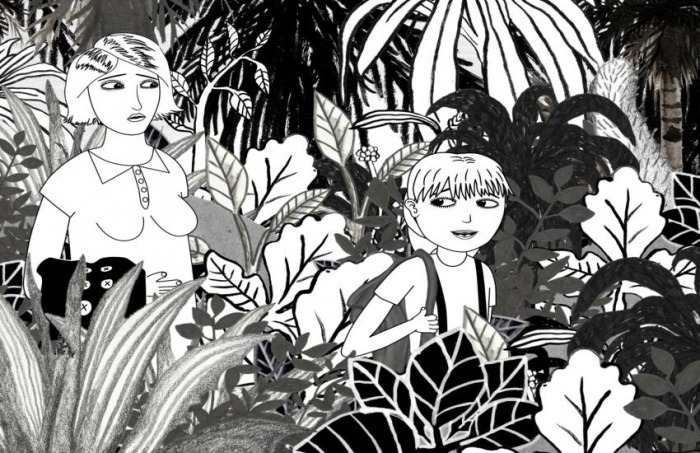
Growing up is never easy, but divorce, money problems, and moving between two countries makes things much harder for Paola, the young Ecuadorian-Colombian girl at the heart of Power Paola’s deeply personal graphic novel. Power Paola, the pen name of Paola Gaviria, uses colorful anecdotes about her parents, two older sisters, and housekeeper to explore her life story from the time she was conceived to when she became a young woman.
Now, the author has also become a filmmaker. Power Paola teamed up with director Santiago Caicedo to bring her 2011 graphic novel to the big screen via animated movie Virus Tropical. She was heavily involved in the production, as the pair told Remezcla during the sunny Festival Internacional de Cine de Cartagena de Indias in Colombia. During our conversation, the director and writer-illustrator discussed their collaborative process, the importance of telling women’s stories, and the honesty that comes with writing about your life. Here are a few of the highlights from our discussion.
On Finding and Adapting Power Paola’s Breakthrough Graphic Novel
Santiago Caicedo: Well, first I found Paola. We’ve been good friends for a long time. I knew the story before it was made. She used to post frames [from the book] on a blog. Every week, she used to post one new page from the book. I felt a big responsibility. I wanted to be very respectful because it’s Paola’s life. It was important to be truthful and to be as faithful as possible to the original graphic novel. I was more than nervous.
On How Long It Took to Produce the Film
Power Paola: It took five years to do all of the drawings [5,000 sketches]. It was [like doing] a portrait, for me to sketch the drawings from memory. It was much easier just to do it myself than to tell someone else my sister’s clothes looked a certain way, the furniture looked like so. I preferred doing it this way because it was like an inventory of my life.
Caicedo: We basically started from scratch. There were some scenes [that were] quite easy for us, because Paola had to draw them. We would get a lot of raw material and build things up. I think my big challenge was to give life to these characters. Even if they were animated, I wanted them to have a lot of life.
Paola: In the script, we made a list of everything – people, floors, details, everything – then I drew them. I had to send them separately to Santiago and his group in Colombia. That way, we made the scenes and locations real.
On Adding Surrealistic Flourishes to Her Life Story
Paola: Things happened in my life, but I was interested in making my autobiography very colorful. I wanted to add another dimension to what my family went through apart from the social context. I liked that people could recognize specific places or noticed the family’s accent was authentic to that time and place in the ‘90s. That was very important to me.
On the Rising Interest in Women’s Stories
Paola: In the beginning, I didn’t think about that. It was just my story. I was always a feminist even without using that title. These days, we talk a lot about the moment and my story talks a lot with the social climate we’re living in now. We show that women can take ownership of their stories, their lives and make their own decisions. We don’t need to ask for permission. We’re each our own owner and we do whatever we want to do. The timing was just right for this story.
I love women’s stories. I love their voice. It was rare to find comic books [and graphic novels] by women, and now, it’s not like that. At that moment, you felt like the drawings were also telling you something. Now, that feeling is not so noticeable between men and women writers.
On Creating the Eye-Popping Visual Style of Virus Tropical
Paola: It’s important to me to experiment. Over five years [of working on the project], I couldn’t draw everything the same way. I stopped thinking about how I could make the best drawing. You’ll notice some drawings are not as pretty as others. There are some drawings that are more expressive or more animated. There are many distinctions.
Caicedo: You sometimes have more sketchy animation than finished animation. It also has to fit within the character’s story. The main character is not finished, she’s only just starting to understand who she is. Animation-wise, that’s a lot of things we wanted to use: unfinished, sketchy drawings. It became a personality trait. You sometimes will also see super complex, almost baroque frames with a lot of information.
On Power Paola’s Influences for Virus Tropical
Paola: At first, I knew I wanted to tell my story from conception to my 18th birthday. How did I do that? I remember I read Persepolis and the comic book Flores en la Nieve, and that story came in chapters. Ah, that’s how I want to do this. I imagined I would focus on the structure and the personas that matched with themes. My mom would worry about money, my dad about religion. From there, I started to tell short stories and went on chronologically from there. That was the structure that I came up with.
** This article was also published in ReMezcla.
